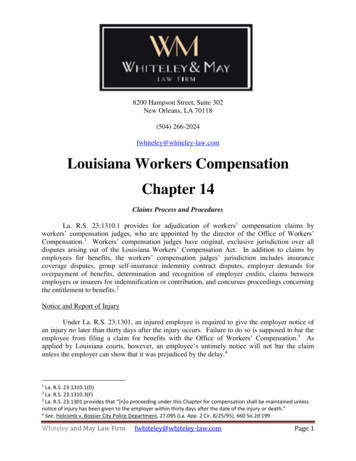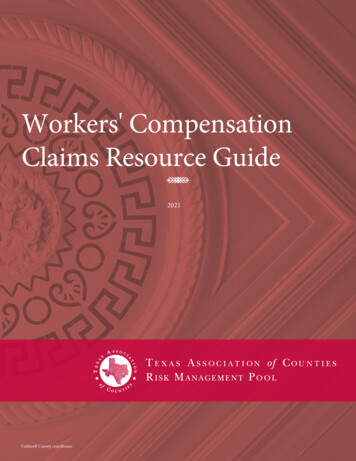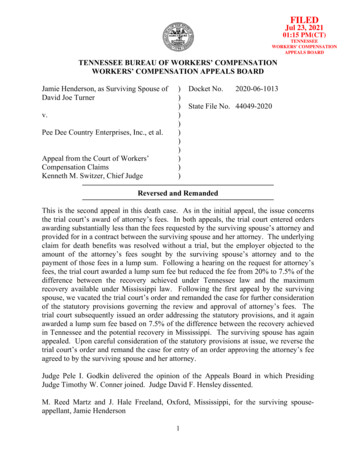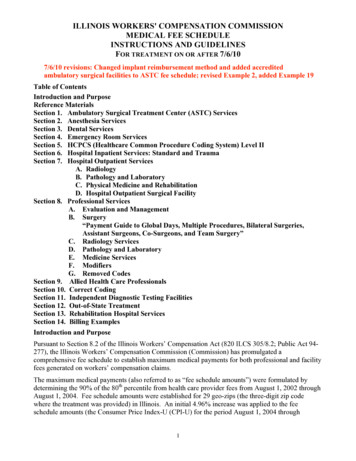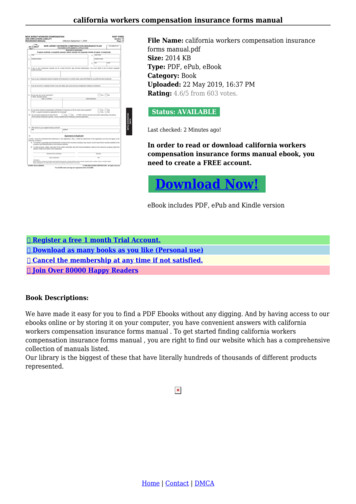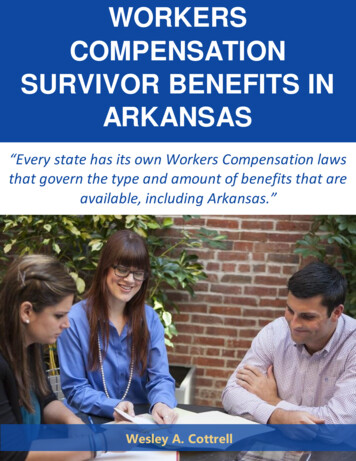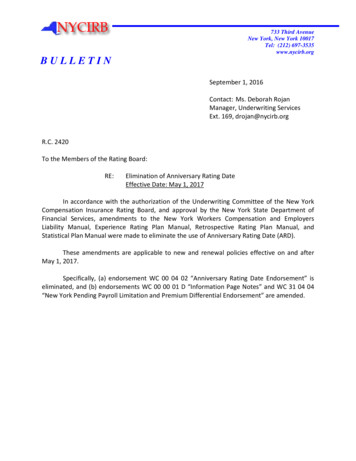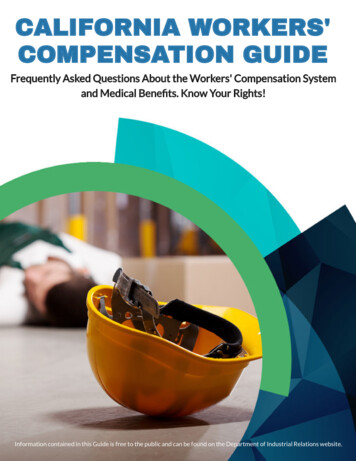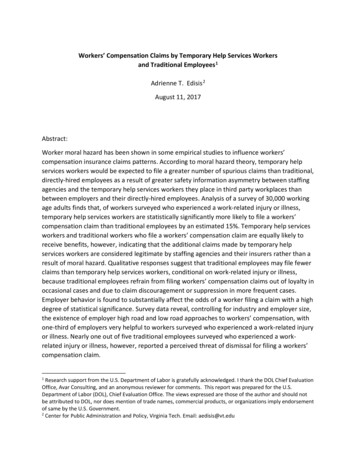
Transcription
Workers’ Compensation Claims by Temporary Help Services Workersand Traditional Employees 1Adrienne T. Edisis 2August 11, 2017Abstract:Worker moral hazard has been shown in some empirical studies to influence workers’compensation insurance claims patterns. According to moral hazard theory, temporary helpservices workers would be expected to file a greater number of spurious claims than traditional,directly-hired employees as a result of greater safety information asymmetry between staffingagencies and the temporary help services workers they place in third party workplaces thanbetween employers and their directly-hired employees. Analysis of a survey of 30,000 workingage adults finds that, of workers surveyed who experienced a work-related injury or illness,temporary help services workers are statistically significantly more likely to file a workers’compensation claim than traditional employees by an estimated 15%. Temporary help servicesworkers and traditional workers who file a workers’ compensation claim are equally likely toreceive benefits, however, indicating that the additional claims made by temporary helpservices workers are considered legitimate by staffing agencies and their insurers rather than aresult of moral hazard. Qualitative responses suggest that traditional employees may file fewerclaims than temporary help services workers, conditional on work-related injury or illness,because traditional employees refrain from filing workers’ compensation claims out of loyalty inoccasional cases and due to claim discouragement or suppression in more frequent cases.Employer behavior is found to substantially affect the odds of a worker filing a claim with a highdegree of statistical significance. Survey data reveal, controlling for industry and employer size,the existence of employer high road and low road approaches to workers’ compensation, withone-third of employers very helpful to workers surveyed who experienced a work-related injuryor illness. Nearly one out of five traditional employees surveyed who experienced a workrelated injury or illness, however, reported a perceived threat of dismissal for filing a workers’compensation claim.Research support from the U.S. Department of Labor is gratefully acknowledged. I thank the DOL Chief EvaluationOffice, Avar Consulting, and an anonymous reviewer for comments. This report was prepared for the U.S.Department of Labor (DOL), Chief Evaluation Office. The views expressed are those of the author and should notbe attributed to DOL, nor does mention of trade names, commercial products, or organizations imply endorsementof same by the U.S. Government.2Center for Public Administration and Policy, Virginia Tech. Email: aedisis@vt.edu1
IntroductionThe declining rates of reported work-related injuries and illness since the early 1990shave been partially explained by changes in state workers’ compensation laws, shifts inemployment across industries, and incidence rate declines within industries. (Boden and Ruser2003, Morse et. al. 2009, Guo and Burton 2010, Ruser 2014) Both workers and employers havefaced changing incentives vis-à-vis workers’ compensation insurance claim filing. Workers, dueto more stringent eligibility requirements and restrictions in many states, confront a strongerdisincentive to filing a workers’ compensation claim. Employers, as a result of increases inworkers’ compensation insurance deductibles and self-insurance, have a stronger incentive toavert the filing of a workers’ compensation claim.A downward trend in workers’ compensation benefits payments has accompanied theongoing decline in reported work-related injuries and illnesses. (Baldwin and McLaren 2016)The rise in alternative work arrangements may be another relevant factor contributing to thetrend since some workers in alternative work arrangements do not qualify as employees andare therefore not eligible for workers’ compensation insurance benefits. Employment inalternative work arrangements, such as independent contracting, temporary help services, oncall work, and freelancing, increased from 9.3% of those employed in 1995 to an estimated17.2% in 2015. Nearly all of the net employment growth in the U.S. economy from 2005 to 2015occurred in alternative work arrangements. (Katz and Krueger 2016) While workers classified asindependent contractors are not considered employees and are ineligible for workers’compensation, temporary help services (THS) workers are considered employees for thepurposes of workers’ compensation. Temporary help services agencies, also known as staffingPage 2
agencies, are required to carry workers’ compensation insurance or self-insure according to thesame state regulations as other employers.Empirical analysis has shown that THS workers experience a higher incidence of workrelated injuries and illnesses than standard, directly-hired workers. (Underhill and Quinlan2011, Silverstein et. al. 2002, Foley 1998, Mayhew et. al. 1997) Whether THS workers are moreor less likely to collect workers’ compensation benefits is unclear. One study estimated that THSworkers incurred higher workers’ compensation insurance costs than similar non-contingentworkers. (Park and Butler 2001) Another study found THS workers had lower awareness ofworkers’ compensation benefits than directly-hired workers. (Mayhew and Quinlan 2002)Arguments have been made that the growth of precarious employment has contributed to thedecline in workers’ compensation benefits by preventing workers from reporting some injuriesand illnesses. (Azaroff et. al. 2004)THS status has the potential to affect claiming and safety incentives in a number ofways. The current research investigates whether THS workers have a higher or lower propensityto file workers’ compensation claims than traditional standard, directly-hired workers. Theresearch also considers the factors affecting the propensity to file a claim of THS workers andstandard workers, and the implications of similarities and differences. Data were collectedthrough a large scale mobile phone-based survey, which improves access to employed adultsand to younger adults increasingly underrepresented through traditional survey methods. (Linket. al. 2007)Page 3
Background and Literature ReviewAsymmetric information and moral hazard have long been considered potentialimpediments to efficiency in insurance markets. 3 In the workers’ compensation insurancemarket, moral hazard associated with information asymmetry has been proffered as a factorinfluencing workers’ compensation claims patterns. Behaviors on the part of insured employersand workers that deviate from behaviors without insurance in ways that increase risk representmoral hazard. Ex ante moral hazard in workers’ compensation insurance markets refers tobehaviors of insured employers and workers that precede workplace injury, such as decreasedinvestment in worker safety by employers or reduced attention to safety by workers. Ex postmoral hazard in the market for workers’ compensation insurance concerns the effects ofinsurance incentives on claiming behaviors after an incident of injury or illness. The existence ofinsurance, in theory, creates an incentive for workers to claim losses to the full extent of andpossibly beyond what the framework of allowable losses permits.Differences between THS and standard, directly-hired workers both in ex ante and expost moral hazard may arise due to differences in employer and worker incentives. Staffingagencies have less access to information about and, more importantly for ex ante moral hazard,less control over worker safety. The firms that use staffing agencies, moreover, have lessincentive to invest in THS worker safety than the safety of their directly-hired workers since THSworkers are not covered by their workers’ compensation insurance and THS worker injuries orillnesses do not affect their experience rating. The high frequency and severity of THS workerKenneth Arrow introduced asymmetric information, moral hazard, and adverse selection in his seminal 1963article.3Page 4
work-related injury as a consequence has been well documented. (Mayhew et. al. 1997, Foley1998, Silverstein et. al. 2002, Underhill and Quinlan 2011)Asymmetric information is a relevant differentiator in ex post moral hazard betweenTHS and standard, direct hire employment arrangements. Employers have more information onthe safety practices and incidents of injury or illness of standard, directly-hired workers thanstaffing agencies have about the safety practices and incidents of injury or illness of THSworkers placed at client firms’ work sites. Because staffing agencies have limited information touse to contest a claim, THS workers could be expected to seek to file a greater number ofspurious claims than directly-hired employees.Evidence on the claims behavior of all workers, more generally, is contradictory.Research finding evidence of moral hazard by workers in filing workers’ compensation claimsstands in contrast to empirical research revealing substantial under-claiming of work-relatedinjuries and illnesses. Research focusing on moral hazard on the part of workers is discussedbelow, followed by a review of research on insurer efforts to mitigate against employer moralhazard through experience-rating. Empirical evidence on claims-filing is subsequentlypresented, and the limited literature on THS workers’ compensation claims is discussed.Worker Moral Hazard. Early work on potential worker moral hazard by Krueger (1990)using Current Population Survey microdata from 1983 to 1985 found an association betweenhigher levels of workers’ compensation benefits and higher incidence of workers’ compensationclaims, controlling for worker characteristics and other state-specific workers’ compensationprogram characteristics. Butler (1994) similarly found that the incidence and severity of claimsPage 5
increased as benefits increased and attributed the increased benefit utilization to ex post moralhazard rather than a decrease in effort to preventing work-related injuries by workers. Erin andBronchetti (2012) undertook a comprehensive analysis of the elasticity of response of workerclaims behavior to higher workers’ compensation benefits using a Current Population Survey 25year time series from 1977 to 2004 that yielded results contradicting Krueger (1990) and Butler(1994). They found that with additional controls, including for levels of prior earnings, highercash benefits for workers’ compensation were not found to be correlated with higher incidenceof receiving workers’ compensation. While the finding of no evidence of moral hazard behavioron the part of workers is attributed to the additional controls, the difference in time periodstudied cannot be ruled out as a factor affecting the results. It is possible that the more recentdata reflect changes in the extent of moral hazard behavior of workers since the early 1980sdue to changes in state workers’ compensation insurance programs, terms of workers’compensation insurance policies, and resultant incentives.Other research has investigated difficult-to-diagnose injuries as a proxy for injuriesinvolving greater information asymmetries and therefore having greater potential for behaviorconsistent with moral hazard. Empirical analysis of administrative data from 1978 to 1982showed that workers with hard-to-diagnose injuries obtained benefits of greater variation thanworkers with clear-cut injuries, which researchers attributed to the effect of moral hazard onworkers’ claim behaviors. (Dionne and St. Michel 1991) Consistent with this finding, empiricalanalysis of the construction sector in Quebec from 1977 to 1986 found higher levels of workers’compensation benefits were associated with a higher incidence of workers’ reporting hard-todiagnose injuries than clear-cut injuries and ascribed the change in composition to moralPage 6
hazard. (Bolduc et. al. 2002) More recent study of the phenomenon of proportionally higherworkers’ compensation insurance claims by workers on Mondays, however, has yieldedambiguous findings on worker moral hazard. Analysis of filings of a single large employer from2010 did not show higher benefits contributing to a higher incidence of soft tissue injuryreports on Mondays. (Butler et. al. 2014) The existing research has not demonstratedconclusively that cases of greater information asymmetry lead to additional, potentially moralhazard-related claims.Employer Experience-Rating. Insurers’ main prospective approaches to management ofex ante moral hazard in the market for workers’ compensation insurance include partialinsurance coverage and premium levels based on past experience. In practice, insurers requiredeductibles, which have increased notably over the course of the past decade. 4 Insurers alsoapply experience modification penalties to insured employers with poor worker safety records.While experience modifications serve to improve the alignment of the incentives of employerswith those of insurers, they generate conflicting incentives for employers versus workers. Theself-interested behavior of employers subject to experience–based rate modifications is tominimize workers’ compensation claims.The literature on experience modifications corroborates the theorized incentive foremployers to reduce workers’ compensation claims. Experience modifications are referred to asan “injury tax,” intended to encourage employers to improve worker safety through workplacesafety and training initiatives. (Moore and Viscusi 2014) Multiple studies have revealed resultsInsurers require deductibles in 45 states. Deductibles are not allowed by the state monopolies - North Dakota,Ohio, Washington, and Wyoming –or in Wisconsin.4Page 7
consistent with the hypothesis that experience modifications catalyze employers to implementmeasures to improve working conditions and/or reduce work-related injury claims. (Lengagne2016, Tompa Sheilah et. al. 2012, Barth et. al. 2008, and Thomason and Pozzebon 2002) Theintroduction of experience rating and increase in degree of experience rating are bothassociated with a lower frequency and severity of injuries based on moderate evidence,according to a meta-analysis by Tompa Cullen et. al. (2012).Most research on the effects of experience modifications that identify a relationshipbetween experience rating and reduced claims activity, however, do not clarify whether theobserved relationship is due to occupational safety and health improvements or claimssuppression. (Mansfield et. al. 2012). Puelz and Snow (1997) investigated empirical contracts tomanage workers’ compensation costs, finding that managers under-reported less severeinjuries and illnesses to meet their targets. Thomason and Pozzebon (2002) report thatemployers subject to experience-rating were more likely both to put in place preventivemeasures to improve safety and to implement aggressive claims management.Workers’ Compensation Insurance Claims Filing. While early moral hazard literature onworker claims for work-related injuries and illnesses identified a slight increase in claims forhard-to-diagnose injuries associated with higher benefits, more recent work on the effects ofbenefit levels and on Monday filings do not yield evidence of worker moral hazard behaviorleading to increased benefit payments. The literature investigating the proportion of claims forwork-related injuries and illnesses for which claims are filed is unambiguous in its verdict thatmany workers do not file claims for potentially eligible injuries and illnesses. This suggests thatit is possible that employer incentives against claims filing created by experience-rating ofPage 8
employers are outweighing worker incentives to file claims due to worker moral hazard in manycases.Analysis of data from a sample of workers in Michigan drawn from a survey andadministrative data showed that 45% of workers who missed work due to an injury did not filea claim for workers’ compensation benefits. (Biddle and Roberts 2003) Of the roughly 350respondents to a Washington State survey who reported a work-related injury or illness, 48%did not file a workers’ compensation claim. The propensity of workers to file a claim variedacross industry and occupational groups. (Fan et. al. 2006) A mixed methods study of workers inthe health care industry, which accounts for approximately one in five reported work-relatedinjuries or illnesses, 5 indicated that 55% of injured workers did not file workers’ compensationclaims. (Galizzi et. al. 2010) Out of a sample of 1,020 union carpenters, 30% expressed theperception that work-related injuries were almost never or rarely reported. (Lipscomb et. al.2013)Studies of workers not filing potentially eligible claims have yielded several potentialexplanations. The reasons for failing to file a workers’ compensation claim are, in manyinstances, tied not only to the nature of the injury itself, but also to environmental conditions inthe employing firm. Examination and empirical analysis of documentation from multipleadministrative sources by Azaroff et.al. (2002) revealed that workers failed to report job-relatedinjuries due to concern that filing a workers’ compensation claim would be considered anindicator of a worker’s insufficient attention to risks or a tendency to express grievances, which5Data are from the Bureau of Labor Statistics Survey of Occupational Injury and Illness (SOII).Page 9
could inhibit career advancement. Lackdawalla et. al. (2007) concluded, based on data from theBLS National Longitudinal Survey of Youth, that because workplace environment and employerheterogeneity critically affect worker decisions about workers’ compensation claim filing, anyefforts to increase the use of workers’ compensation would depend on influencing employers.Supplementing quantitative and qualitative inquiry with onsite research in the health careindustry, Galizzi et. al. (2010) observed that failure to file a claim is explained by time pressureand worker concerns about eligibility and adverse effects on reputation, future earnings andcareer advancement.Spieler and Burton (2012), in their synthesis of literature seeking to explain thediscrepancy between the number of people disabled due to work-related injuries or illness andthe number of people who receive workers’ compensation benefits cite exclusions of categoriesof workers from coverage, failure to file by individual workers, and barriers to approval andreceipt of benefits. The procedural challenges faced by those injured or ill workers who file aclaim, including higher standards of evidence introduced through workers’ compensation lawamendments during the 1990s, reduce the success of claims. In other words, not only employerconditions, but also increasingly restrictive rules for compensability in many state workers'compensation programs have reduced benefit receipt.Temporary Help Services Worker Claims Behavior. The heterogeneity of workers’ claimsbehaviors across sectors and occupational groups implies that averages across samples andreporting patterns in industries and occupational groups such as health care and carpentry maynot provide insight into the claims behavior in the temporary help services sector. The results ofthe limited research reporting on workers’ compensation claims by THS workers employedPage 10
through staffing agencies are contradictory. Mayhew and Quinlan (2002) determined that THSworkers in the fast food industry had lower awareness of workers’ compensation policies thandirectly hired workers. In contrast, Park and Butler (2001) reported, based on analysis ofworkers’ compensation claims by THS workers in Minnesota from 1991 to 1996, that workersemployed through staffing agencies incurred workers’ compensation costs four times those ofstandard workers. They found both higher degrees of severity of claims and higher claimfrequency rates and ascribe the difference in part to moral hazard behavior on the part ofstaffing agency workers. In the 20 years elapsed since the study period for the Park and Butlerresearch, THS worker occupations have diversified, including into higher skill and higher payingjobs, and shifted into manufacturing, transportation, and health services. (Dey et. al. 2017, Luoet. al. 2010, Katz and Krueger 2016) The number of temporary help services workers has grownby 149%. 6 With the maturation and expansion of the THS employment industry over the past20 years, claims patterns and behavior may have evolved.Temporary help services workers have been shown by several studies over an extendednumber of years to have a higher level of injury than directly-hired workers. (Mayhew et. al.1997, Foley 1998, Silverstein et. al. 2002, Underhill and Quinlan 2011) The high incidence ofwork-related injury may be explained in part by the short tenure of staffing agency jobs, whichlast on average 12-14 weeks. 7 Breslin and Smith (2006) demonstrated an association betweenshort tenure at a particular workplace to increased risk for injury due to lack of familiarity withwork practices and the workplace, insufficient safety training, and the higher probability ofData from the BLS Quarterly Census of Employment and Wages, accessed 12/22/2016.From the American Staffing Association at m, accessed on1/9/2014.67Page 11
short tenure workers being younger. Short tenure may not fully explain higher THS workerinjury rates, however. Ellen et. al. (2012) found, through focus groups and in depth interviews,that employers, in some instances, purposefully hired THS workers to carry out riskyassignments in order to protect their standard, directly-hired employees. With the precariousnature of the contract, moreover, THS workers may have less ability to refuse hazardous workor petition for appropriate protective equipment. (Mayhew et. al. 1997)The incentive effects of experience rating on staffing agencies may differ than theeffects on other employers. As the “employers of record” for the worker, staffing agencies areresponsible for compliance with all labor regulations, including state workers’ compensationinsurance requirements. While staffing agencies obtain workers’ compensation insurance forTHS workers and are subject to experience modifications based on injuries to their workers,they do not directly control the training and safety measures that may affect the likelihood ofworker injury. Employers with more injuries that lead to filing of workers’ compensation claimspay higher workers’ compensation insurance rates. Staffing agencies are subject to similarincentives to avoid injuries for which claims are filed as standard employers but limited in theirability to respond to the incentives. The incentive to avoid costly experience resulting fromworkers’ compensation claims filing, moreover, may be weaker for staffing agencies. Staffingagencies are reputed to charge client employers for workers’ compensation insurance costs forthe THS worker through their mark-up over the wage rate.MethodsThe objective of the research is to gain empirical understanding of workers’compensation claiming behavior of temporary help service workers hired through staffingPage 12
agencies and workers directly hired by employers, which requires access to both categories ofworkers. THS workers represented 2.9% of the U.S. workforce in 2015. 8 As Foley et. al. (2014)point out, given the small percentage of the workforce employed through staffing agencies, asurvey of establishments may fail to capture a robust picture of THS workers placed in thirdparty workplaces across the range of industries. To reach a broad group of THS workers, theresearch relies on a survey of workers accessed directly.Survey. The methodology for gathering data on workers’ compensation claims behaviorof directly-hired and THS workers is a large scale mobile-phone based survey. The use of mobilephones to deliver the survey addresses shortcomings of traditional landline based surveys. Dueto an increase in the proportion of adults who are either exclusively or primarily mobile phonesubscribers, traditional surveys relying on direct dial to landlines increasingly suffer fromnoncoverage error, declining contact and cooperation rates, reduced representativeness, andlower data quality. (Steeh et. al. 2007)While comparability across mobile phone-based surveys is limited by rapidly evolvingpopulations, platforms, and features, mobile phone-based surveys have performed well inexperimental studies. (Link et.al. 2014) De-Bruijne and Wijnant (2014) found higher surveycompletion rates for surveys taken using smartphones than for other devices. Ha et. al. (2016)found equivalent data quality between surveys taken on smartphones and laptops, althoughlaptop entered surveys had higher completion rates on open-ended questions. Given the8Data from the BLS Quarterly Census of Employment and Wages, accessed 12/22/2016.Page 13
intermittent nature of general cell phone usage, shorter and simpler surveys are consideredmore effective. (Link et. al. 2014)The survey application used is designed to function across a wide range of mobiletechnology platforms, so respondents are not limited to a single or small number of commonplatforms, thereby expanding the sample frame. The flexibility to invite participation ofrespondents across multiple platforms addresses a limitation raised by Buskirk and Andrus(2013) on generalizability as a result of the technology constraint that permitted response byusers of only one operational system.The mobile phone survey method offers advantages in access to the population of THSworkers targeted by the study. It enables greater access to younger and working adults than atraditional survey. (Link et. al. 2007) An estimated 92% of adults owned cellphones in the U.S. in2015, according to a Pew Research Center survey. (Anderson 2015) Smartphone ownershipincreased from 35% in 2011 to 68% in 2015, with 86% of those ages 18-29 and 83% of thoseages 30-49 owning a smartphone. Smartphone ownership was not found to differ across racialand ethnic groups. Smartphone penetration rates are higher among more educateddemographics, but exceed 50% across all income levels. Hence, the mobile phone-based surveymechanism provides access to workers at a range of income levels.While demographic data specific to THS workers have not been collected by the Bureauof Labor Statistics since the Current Population Survey supplement on Contingent andAlternative Work Arrangements (CWS), last completed in 2005 and scheduled to resume in2017, the Census Bureau’s American Community Survey gathers data at the level of thePage 14
employment services industry. 9 Temporary help services workers represented 81% of workerson the employment services industry in 2015. 10 Compared to workers in all industries,employment services industry workers are notably younger, with strong representation in the26-35 year old range. The employment services industry worker population includes morewomen than the total worker population. Workers in the employment services industry are lesslikely to have earned an advanced degree beyond college, with only 7% holding a degreebeyond a bachelor’s degree compared to 12% of the population. (Nicholson 2015)Katz and Krueger (2016) conducted a survey that sought to replicate the CWS on asmaller scale. Logit regression analysis indicates that workers with less education have a higherprobability of holding THS jobs than workers with higher levels of education. Although theproportions of workers in all forms of alternative work arrangements show that White workersrepresent 80% of all workers in alternative work arrangements, the likelihood of an AfricanAmerican or Hispanic worker being a THS worker appears to be higher than that for a Whiteworker in their sample of THS workers. The Katz and Krueger estimates regarding THS workers,however, are based on a small number of THS workers – 35 out of the total sample of 2,196workers.As with an online survey, the sample recruited for the mobile phone-based surveycannot be considered random. Probabilistic inferences to the population of workers cannot bemade. (Tourangeau et. al. 2013) A 2010 survey comparison study, however, found that an optData from the Census Bureau’s American Community Survey were drawn from Nicholson 2015.Employees of professional employment organizations and executive search services constitute the balance of theindustry. Calculations are based on data from the Bureau of Labor Statistics Quarterly Census of Employment andWages, accessed 1/4/2017.910Page 15
in online panel produced results as accurate as a random digit dialing sample. (Ansolabehereand Schaffner 2014) Moreover, the post-survey stratification of the sample into standardworkers and THS workers allows for testable comparisons to be made between the two groupswithin the sample.The 2005 CWS yielded a lower share of THS workers in the workforce based oninformation provided by individuals about their employment arrangements, than the sharecalculated based on the Current Employment Statistics based on data provided by employers.(Bernhardt et. al. 2016) The difference between these two surveys raised questions aboutworkers’ ability to identify themselves as THS workers. A possible confounding issue in the caseof the CWS was the use of the term “temporary” both to describe the expected duration ofemployment or disability early in the survey and to describe a type of employer later in thesurvey when trying to identify THS workers. 11This survey included only one usage, in the expanded expression “temporary helpagency or staffing agency” to describe employers of THS workers in order to facilitate THSworker self-identification. Further, this survey not only asked the respondents who paid them,as in the CWS, but also inquired about the nature of the posi
workers' compensation insurance deductibles and self-insurance, have a stronger incentive to avert the filing of a workers' compensation claim. A downward trend in workers' compensation benefits payments has accompanied the ongoing decline in reported work-related injuries and illnesses. (Baldwin and McLaren 2016)
